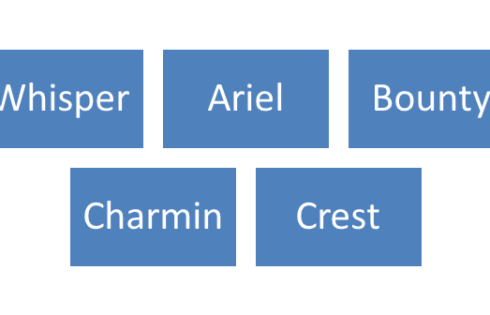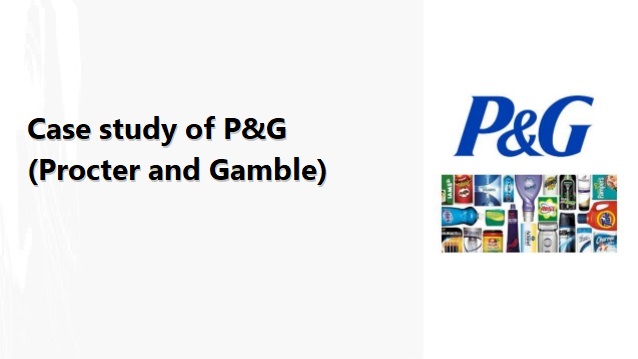Background of Procter and Gamble
Procter and Gamble is an USA based food producing company. It is established in 1837. It has a wide range of personal as well as consumer health care service provider in the globe. These products are arranged in multiple different segments. It also involves the beauty, grooming, and healthcare, feminine and family care. The food portfolio of this company includes snacks, beverages and foods.
P&G is placed in Ohio. According to Ana, Marketing head from Myassignmenthelp, In 2014, P&G was recorded $83.1 billion in sales department. On August 1, 2014, P&G highlighted, it was streamlining the company, dropping and selling off around hundred brands from its product portfolio for focusing the remaining sixty five brands, which produced ninety five percent of the company’s profits”. A. G. Lafley—the company’s chairman, president, and CEO until October 31, 2015—said the future P&G would be “a much simpler, much less complex company of leading brands that’s easier to manage and operate”.
About P&G
| 1. Chief Executive Officer of the company is David S. Taylor. |
| 2. The products of the Procter and Gamble are Whisper, Ariel, Bounty, Charmin, Crest, Dawn and Downy. |
| 3. Annual revenue of Procter and Gamble is US $66.832 billion. |
| 4. P&G Company operates their stores in Asia, Central and Eastern Europe, Latin America, North America and Western Europe. |
| 5. The total operating cost of the company is $62.197 B. |
| 6. The ad expenditure of the company is $350 million. |
| 7. Total sales volume of the company is 67.7 billion. |
| 8. The main competitors of the company are Marico, Newell Brands, Unilever, Johnson and Johnson, Edgewell Personal Care, Henkel and Estee Lauder. |
BCG matrix of the company

Figure 1: BCG matrix of the company
SWOT analysis
Strengths
Protecter and Gamble strengths enable the business for maintaining its position in the market. It has high level of competition with the other consumer goods firms. This element of the SWOT Analysis deals with internal strategic factors that support business growth and expansion. Such factors enable Procter & Gamble to counteract the negative effects of competition. The company must build on its current strengths, while also developing more capabilities to further strengthen the business. The case of this SWOT analysis of Procter & Gamble highlights the following strengths:
- Strong goods for the consumers
- Scale for the economics
- Efficient product distribution network.
It provides the company a competitor advantages. Tide and Pampers are the household name that contributes the loyalty of the consumers. Economies of scale are treated as the strength of the company that is based on the global scale of the operation of the company. The main advantage of the company has the high processing efficiencies. It is totally based on the size the company. They have a huge amount of cost efficiencies based on the size of the company.
It has a huge distribution network of the manufactured product. This network has company owned facilities. The strength shown in this in SWOT analysis. It also shows product efficiencies.
Weakness
Despite of the prominent market position, Procter and Gamble has lots of weakness. In this element of the SWOT Analysis, internal strategic factors that limit business improvement are identified. These factors create difficulties in implementing Procter & Gamble’s strategies. For example, the company encounters challenges in enhancing its competitive advantage because of weaknesses in internal processes. Procter & Gamble must address the following weaknesses to minimize such challenges in its consumer goods business:
- Limited amount of online presence
- Limited degree of business diversification.
The main weakness of the company is the imitable nature of the products. The weakness is very typical where the products are from consumer good market. Procter & Gamble susceptible to imitation, which could reduce market share. Limited online presence is another weakness of the company. Retail companies and manufacturers are continuously increasing their online operations. For example, many small and large consumer goods firms are using their respective e-commerce websites to sell products online. However, Procter & Gamble’s e-commerce website, the P&G Shop, has limited presence that operates mainly in the United States. This condition limits the benefits that the company gets from the global online market.
The improvement of the online presence of the company will boost the competitive advantage. There is a limited degree of diversification.
- Online presence makes the company highly dependent on the goods market of the company.
- Due to online presence, the exposure of the company is maximise and it hampers the market risks of the company.
- It gives strategic reformation of the e-commerce sector as well as business diversification of the products.
Opportunities
It can provide lots of opportunities of the growth and it expands the global consumer goods. SWOT provides some external strategic factors for the company and it also provides the development of the company. The company can enhance the opportunities. It represents various opportunities for the growth of the business. The company can enter into other industries by developing the other products. It gives new sources of income. There is a massive opportunity for the online presence of the positive impact.
The e-commerce websites are responsible for various profits of the company. A stronger influence on the growth and improvement to its competitive advantages.
Threats
The external conditions can reduce the performance of the Procter and Gamble. It is threating the business and it provides the external strategic factors. It helps to identify the element of the SWOT analysis. They must continue the monitoring of the external environment. It is used to detect the threats. It is based on the goods market of the dynamic consumer.
Procter and Gamble must continue some improvement for the addressing the threat of competition. Competitors are always looking for various procedures for looking for achieving the global market. It reduces the company’s market share. Competition can be a great external factor for the company. It affects the goods services of the consumer.
This threat is entirely related to the imitable nature of the consumer goods business. It provides various trade policies that gives serious restriction of the consumer goods. It provides a huge strength on the competitive advantages for giving protection to the business threats in the company.
PESTEL analysis
Political
The political landscape impacts how Procter & Gamble implements strategies that satisfy policies and governmental requirements on business development. This element of the PESTEL/PESTLE Analysis framework evaluates the influence of governments and related organizations or institutions on the remote or macro-environment.
Economical
The Procter & Gamble Company’s performance in the consumer goods industry is directly based on the economies where the business operates. The effects of economic trends and issues on the remote or macro-environment are determined in this element of the PESTEL/PESTLE Analysis framework. The opportunity linked to the high growth rate of developing markets supports Procter & Gamble’s potential growth. For example, increasing penetration into developing countries can drive the company’s overall global growth.
Social factors
It affects in terms of the behaviour of consumes and workers. Social factors also deals with the socio-cultural conditions of the company. It gives threats in the macro-environment firms. Consumers are enhancing their preferences of the company. It expects the increase in the potential revenue. The company can improve the health effect of them. It happens in many development countries.
Technological factors
The Procter & Gamble Company depends on technologies to support its consumer goods business. Also, technological advancements affect consumers’ behaviors and purchases decisions. Such effects of technological tools, changes and trends are identified in this element of the PESTEL/PESTLE Analysis framework.
Legal factors
It is used to ensure the legal compliance of the consumer and it helps to improve the popularity of the company.
Problems of Procter and Gamble
It drags into proxy fight with active investor and the stock price was increased to thirty two percent and it gives 20.5 per years forward earnings. According to My assignment help marketing department, “It is looking for the growth of the company and it reports the reciprocal of first quarter of 2018 and it rises to $16.9 billion in the year. It has a same problem in the previous years”. Procter & Gamble is projected to have minimal revenue growth over the next three years, with revenue rising from $67.15 billion in 2018 to $71.76 billion in 2020. The company needs to find a way to drive more growth to get its stock rising again.
Resolving the issues
They should develop such a business strategy that helps to gain revenue from emerging markets. Then it will be coming from the developed markets. It is totally concentrated in the slower down markets. The business analyst should help the company very efficiently so that it resolves the weakness in the developed markets. The volume will be increased if they follow this policy. It gives the sales growth and volume of growth. It is likely to see the same issues. If they adopt efficient business strategy then they can resolve the issue.
The problems are rooted in the products. It is totally related to the slow movement of the market. It is used to resolve the growth problems in a larger basis. They can adopt a long term thematic portfolio.
Author Bio: Keira is an experienced marketer, working on behalf of the brand Essaycritics.com. She is dedicated for students. Apart from that, Keira is a legal practitioner, coming all the way from Melbourne, Australia.




